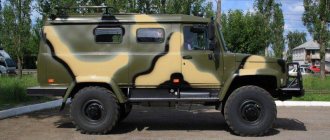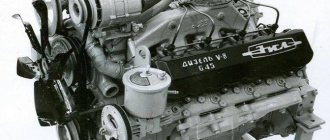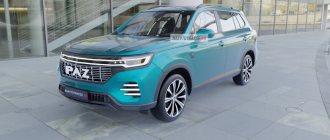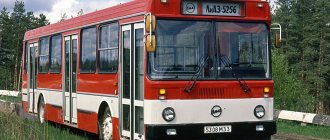The segment of compact and, as a result, cheap pickup trucks is gaining popularity today. Moreover, in this sector of the world market there is a very limited number of models. In fact, the most popular representatives now are the Hyundai Santa Cruz and Ford Maverick. In Russia, this segment is filled (owned by AvtoVAZ), which produces a limited edition pickup truck based on the Lada Niva.
Due to the growing popularity of such cars, it is quite possible that models from other brands will join their ranks. According to our designer, a compact pickup truck can be produced by LiAZ, which today specializes in the production of buses. This opinion may seem strange. However, if we take into account that the Likinsky Automobile Plant has recently been cooperating with GAZ, then the presented car may well appear on the market under the LiAZ brand.
Although it's still just speculation, the pickup truck concept developed by an independent designer looks ready for production. Moreover, stylistically it is closer to the Dacia Duster, which relatively recently acquired a cargo platform. LiAZ-5256 2021-2022 is distinguished by its compact dimensions, which is why it received a one-and-a-half cabin. This is not visible in the images, but there are probably at least 4 seats in the cabin. However, due to such compact dimensions, the rear seats are more likely intended for transporting small cargo or children.
It is still difficult to judge what technical part such a pickup truck might have. The Likino Automobile Plant does not have the technologies and platforms to produce such cars. But if you consider that the company cooperates with GAZ, the latter is able to provide assistance in creating a compact pickup truck. More precisely, the Gorky Automobile Plant in this case can act as an intermediary between LiAZ and Volkswagen. The German concern has the MQB platform, on the basis of which today cars of various classes and sizes are created.
Volkswagen is generally interested in creating a small pickup truck. This is evidenced by the Tarok concept, which was presented in 2018. The German concern recently abandoned the development of this model. But the idea of producing compact pickup trucks under Volkswagen's leadership has support. Therefore, it is possible that VW will transfer the licensing rights to its own platform to another company in order to assess the potential demand for such cars.
Design
As noted earlier, stylistically the LiAZ-5256 2021-2022 pickup truck is more similar to the Dacia Duster, but the Russian model stands out for its sporty design, which is more typical of the Hyundai Santa Cruz. But despite the above, the presented pickup truck has its own, somewhat unique style.
The Russian novelty was created for use in urban conditions. Its compact dimensions allow you to maneuver with confidence in heavy traffic. But at the same time, the car has impressive ground clearance, which allows it to be used beyond smooth asphalt. That is, the presented pickup truck was created for Russian conditions. This is emphasized by the extended square-shaped wheel arches, along which an additional plastic body kit is laid. The latter also extends along the bottom of the side doors, forming a kind of running boards here.
The Russian new product has heavily stacked A-pillars, which smoothly merge into the roof, visually lengthening it. This design solution gives the car a more rapid look. In addition, by increasing the angle of the A-pillars, the developer thereby made the windshield larger, which had a positive effect on visibility from the driver’s seat and reduced the area of “blind” spots.
The body of the Russian pickup truck is completely flat. But above the front volumetric wheel arches, the developer placed a protrusion that visually raises the car a little. The hood goes at a noticeable angle, which once again emphasizes the sporty style. The new product from LiAZ received standard trapezoidal head optics. It is placed in separate niches and is complemented by LED lights. The presented new product is equipped with a huge polygonal-shaped radiator grille with a fine mesh. It protrudes slightly forward, thus forming a kind of “nose”.
The front bumper of the presented pickup truck is embossed. Its smooth curved lines end abruptly, turning into an elongated air intake, which is also placed in a separate niche. On the sides of the air intake are narrow, vertically oriented ventilation openings, above which are mounted barely visible fog lights.
From behind, the LiAZ-5256 2021-2022 looks more like a Dacia Duster. Like the Romanian model, the Russian model has a square-shaped feed. But the rear door of the LiAZ pickup truck has a complex configuration, formed due to numerous bends of the body metal. This stylistic decision gives the stern a broken structure.
The rear optics of the new product are located almost under the very edge of the cargo platform. The perimeter of the latter is formed by curved sheet metal, which forms a kind of compact visor. The rear bumper is complemented by protection, which is fixed at a noticeable angle. This arrangement has a positive effect on the vehicle's cross-country ability.
New semi-low-floor LiAZ - from the passenger’s point of view
A little less than a year ago, we talked about the start of production of new LiAZ-5292 buses in a semi-low-floor suburban version for the Mostransavto carrier from the Moscow region. In mid-June of this year, transport workers reported that the delivery had been completed, and new buses began to appear on the streets of populated areas in the Moscow region. They also went on routes in the city of Korolev, where I live. And I didn’t miss the chance to be one of the first to ride the new LiAZ.
In profile, the new bus looks unusual due to its long rear overhang without a door.
Buses for the Moscow region, which received their own additional index 5292.65-03, became part of the leasing contract between the Ministry of Transport and Infrastructure of the region and the Sberbank Leasing organization. In addition to 632 of these LiAZs, it included another 29 training buses, as well as 27 all-wheel drive towing vehicles (apparently we are talking about the Urals Next, which we wrote about) and five heavy tow trucks (meaning KAMAZ trucks with an 8x4 wheel arrangement - we also talked about them ). Based on the open information presented on the government procurement website, each semi-low-floor LiAZ is valued at 12 million rubles, and the amount of the entire contract is 9,374,062,000 rubles.
On the left is the new semi-low floor, on the right is the urban low floor. Their front masks are the same
Externally, the new LiAZ is maximally unified with the restyled model 5292 - the front and rear masks are similar, and the dimensions are the same. However, if you look from the side, everything falls into place. Due to the fact that there are two doors (single-leaf front and wide double-leaf central), the back of the bus seems unusually elongated. Also noteworthy is the absence of a grille at the rear of the left side: the YaMZ-536 engine produces 276 hp. placed here not like a low-floor one in a separate shaft on the left, but more traditionally - in the overhang. It is paired with a ZF six-speed automatic transmission. The rear axle here is not portal, but the most common one - Raba brand.
The engine moved to its traditional location in the rear overhang
It is interesting that, although these buses are formally considered suburban, in Korolev they also run regular intracity routes. And so far there are not many of them: in order to wait for a newcomer, I had to skip a couple of ordinary low-floor ones.
There are many steps, but they are all low
I enter through the single-leaf front door (the central hinged door works exclusively for exit) and find myself in an unusual salon. It is light and spacious here, like in a city bus, but instead of simple seats there are soft chairs with high backs, three-point seat belts, folding tables and nets for small items. On such a “throne” you can easily survive a long trip, but its resistance to vandalism is obviously lower than that of purely urban hard seats. There are a total of 42 seats in the cabin, and the total passenger capacity is 93 people.
First of all, I went to the gallery - several low steps lead there. It's comfortable to sit - your legs aren't cramped, and the roof doesn't put pressure on you. Vibrations and noise from the engine are felt, but no more than in a similar urban LiAZ. But the ride of the new bus is still rougher - this is especially noticeable when passing speed bumps, of which there are plenty on the city roads. But when driving over bumps, the upholstery is still silent - again, in older low-floor vehicles it already rumbles.
But I can’t say absolutely anything about the operation of the air conditioning system: on the day of my trips it was hot outside, but the drivers of both new buses that I managed to ride on simply did not turn on the air conditioning. Ventilation was carried out exclusively through open vents, and the interiors were downright stuffy.
Having observed the passengers, I can note that the semi-low-floor layout of the cabin organizes them well. Those who have a short distance to travel do not climb up - they either sit in the front part of the cabin, or even stand on a wide storage area in the center. However, I didn’t go during rush hour, so I can’t predict what will happen when the cabin is filled to capacity.
As for my general passenger impressions of the new bus, they are rather positive: the car turned out to be neat and versatile. Albeit with reservations, but such a LiAZ can also work on city routes. However, the most optimal place for its use is quiet country roads. There are still enough of these in our region.
Specifications
As shown earlier, if the presented pickup truck is launched into production, it will be based on the MQB platform. This “trolley” allows you to introduce plug-in all-wheel drive into cars. But in order to reduce the cost of the pickup truck and, as a result, increase its competitiveness, such a transmission will not appear on the LiAZ-5256 2021-2022.
Under the hood of this model can be placed a 1.4-liter turbocharged engine, with which all budget Volkswagen cars come out today. The maximum output of this unit in the basic version reaches 125 hp. In this case, the engine is combined with a choice of manual or automatic transmission at 6 speeds. In more expensive versions of German models, the 1.4-liter engine produces up to 150 hp. and is equipped with a two-disc 7-speed “robot”. Perhaps for the presented pickup truck they will also borrow a 1.6-liter “aspirated” engine. But this option is less likely due to the fact that Volkswagen is now more focused on producing cars that consume little fuel. Author: Fedor Averyev
Lunokhod No. 677: the history of the creation of the LiAZ-677 bus
In 1958, production of ZIL-158 buses was transferred from the Likhachev plant in Moscow to the Likinsky Machine-Building Plant, which in those years produced components for Moscow trucks. Since that time, the plant in Likino-Dulevo was renamed LiAZ.
The first buses left the production gates in January 1959, and during production until 1970, over 62,000 copies were manufactured. The outdated design was also criticized by drivers who sat next to the engine and constantly breathed gasoline vapors, and in the summer they were also fried by the heat from the engine. Another legend was the unsynchronized manual transmission with a complex activation mechanism, which is why the driver of the “158” was very tired by the end of the shift. Well, passengers did not like the narrow wing doors, which greatly worsened the rotation during rush hour.
In the photo: ZIL-158
In 1960, LiAZ designers, with the support of NAMI, built an experimental bus ZIL-E158D, equipped with a hydromechanical gearbox developed by a Moscow institute and a new suspension on air springs. A number of elements tested on the experimental design subsequently formed the basis of the modernized ZIL-158V bus, which received a new synchronized gearbox, a stronger clutch and an improved parking brake system. Buses of the ZIL-158 model were produced until 1970, and for several years the 158 shared the conveyor line with the new model. Work continued in the area of improving passenger boarding on the bus.
In the photo: ZIL-158V
In the same year, 1960, another experimental bus, LiAZ-NAMI-E158, was built, equipped with four wing doors. Later, this temporary measure, which was never considered successful, was developed in experimental buses of the LiAZ-676 series. The new buses were built on the chassis of the same ZIL-158, but differed from the latter in a different external design, a new, more powerful V8 engine from the ZIL-130, a hydromechanical transmission and power steering.
In the photo: LiAZ-E676 Experienced
The most interesting of the experimental batch was the articulated bus LiAZ-5E-676, built in 1962, 15.5 meters long. However, the ZIL engine for a heavy and long vehicle turned out to be weak, and the articulation unit was difficult to manufacture. This attempt turned out to be the last opportunity in the Union to build a new “accordion”, and in the following years the legendary Hungarian Ikarus were actively supplied to the Soviet PATP.
In the photo: LiAZ-5E-676, photo: fotobus.msk.ru
LiAZ-677
Analyzing the experience of building experimental buses, NAMI and LiAZ almost immediately realized that a modern bus could be built only by abandoning the outdated ZIL-158V body. The development of a new generation bus began in 1960, and the first prototype was released on November 6, 1962 - on the Anniversary of the Revolution. In the factory documentation, the new generation high-capacity city bus received the index LiAZ-677.
In the photo: LiAZ-677 pre-production
In addition to the new wagon-type body, developed completely from scratch, the new product received a powerful 180-horsepower ZIL-375YA7 gasoline engine, borrowed from the Ural-375 truck, which, unlike its army version, was derated for A-76 gasoline and received new heads blocks and another carburetor. It was thanks to this engine that the LiAZ-677 bus became notorious for its fuel consumption, which could reach 50 liters per 100 km. The consumption was also aggravated by the new two-stage hydromechanical automatic transmission LAZ-NAMI-Lvov 22.17, which, due to the poor build quality of the torque converter, was prone to oil loss and overheating. The box was controlled by a key block on the front panel.
To improve the smoothness of the ride, a dependent suspension of all wheels on air springs was used, and to increase the driver’s comfort, they tried to isolate the engine next to it as much as possible. To increase passenger capacity, the LiAZ used a three-row interior layout and a rear storage area with a lowered floor level and a ramp, and better rotation of passengers at stops was ensured by two pneumatic doors of increased width. In total, the bus could accommodate up to 110 passengers, 25 of whom were seated.
In the photo: LiAZ 677 pre-production
A year later, the experimental bus was presented to the State Commission for Automation and Mechanization, which, after examining the bus, gave it a positive assessment. Traction, technical, running and climatic tests of the prototype were carried out in 1965, for which several vehicles were sent on a test run Moscow-Kharkov-Novorossiysk-Sochi-Tbilisi-Erevan-Ordzhonikidze-Moscow. In 1966, three more experimental buses were built, and the entire first batch of five vehicles was transferred for trial operation to Moscow automobile plants, where they received generally positive reviews from the operators.
Everyone understood that the machines presented for accountable use were still “raw” and had “childhood diseases.” The plant resolved problems as quickly as possible. Due to increased deformation and subsequent destruction of the main load-bearing elements, the body frame was almost completely redesigned, which made it possible to improve the rigidity of the bus, and the suspension kinematics and mounting points for the levers were completely revised. The material of the air spring shell has also changed, the first of which tended to burst under heavy loads.
In the photo: LiAZ 677 pre-production
Test drives / Single Test drive LiAZ-677: you roll to the sound of bottles clinking! Few people will remember what the LiAZ-677 looks like, but you just have to say “cattle carrier” or “lunokhod” and people who understand will nod. Some with an ironic smile, some with a contemptuous smile. But still the majority... 53363 42 130 08/21/2015
Serial production of a pilot batch of buses built using bypass technologies began in 1967, and already in 1968, in order to reduce the weight of the bus and increase its corrosion resistance, some of the external elements of the body skin were made of duralumin sheets, which were attached to the frame with riveting. A number of sidewall elements were made from them (on the left - a sheet under the driver's door and separate sheets to the stern, on the right - sheets between the passenger doors and on the side of the cabin) and the central part of the rear panel, and several more sheets of duralumin were located on the roof. Despite all the advantages of duralumin, by 1982, after modernization, they decided to get rid of the expensive material: even in PATP, during repairs, in most cases steel sheets were installed on buses. Another factor was savings and improved manufacturability of production: riveting of sheets was done manually, and with the production of 10,000 buses per year, the labor costs of the employee turned out to be enormous.
LiAZ-677 moved to the main conveyor, two years later completely displacing the veteran LiAZ-158V. For the creation of the bus, the team of plant workers was awarded VDNKh medals, where one of the prototypes was exhibited in the Mechanical Engineering pavilion. In 1972, the new Soviet bus was shown at the International Fair in Leipzig, where it received a 1st degree diploma and the Great Gold Medal of the exhibition.
In the photo: LiAZ 677
By the way, since 1973, buses of the brand have been exported. Mostly LiAZ-677E went to the Warsaw Pact countries, but a certain number of vehicles also ended up in Cuba. They also worked in the GDR. For the needs of urban transport, from 1973 to 1979, 370 LiAZ-677 buses were purchased, which subsequently operated in small regional centers. In order for the bus to pass certification on the German market and meet all requirements and standards, the lighting equipment had to be completely changed. At the front, rectangular headlights appeared, which were installed on the Moskvich-412, and the place of the standard round taillights was taken by new square ones.
In the photo: LiAZ 677E
In 1976, the Likinsky Bus Plant was awarded the Order of the Red Banner of Labor for organizing the production of new bus models and early implementation of the five-year plan. Of course, almost every year some changes were made to the bus. So, in 1977, new speakers appeared in the cabin, an increased power generator with a built-in relay-rectifier, and already in 1978, an anti-icing system for pneumatic system hoses appeared, emergency shutdown of the “mass” with buttons in the cabin and on the body, as well as a sliding window in the right window driver's cabin.
LiAZ-677M
LiAZ engineers started thinking about serious modernization of the bus back in the mid-1970s. In 1975, a pilot batch of 35 buses was built, which featured a different front design with a plastic grille, and the door leaves were made of aluminum alloy. Inside, the main change was a new truss frame with increased rigidity.
| In the photo: LiAZ 677M pre-production | In the photo: LiAZ 677M pre-production |
Articles / History Not only Ikarus: the Hungarian auto industry during socialism There is an opinion that in Hungary, with the exception of the well-known Ikarus, there was no auto industry of its own. But this is not so: the automotive industry of this country has a hundred-year history! 26861 5 14 04/01/2016
Changes also affected the transmission. The hydraulic transmission has been significantly strengthened, and the installation of a rubber coupling has reduced vibration levels and increased the service life of universal joints. New components appeared in the braking system, which allowed it to meet modern safety requirements.
Buses began to be equipped with sunroofs, initially typical only for suburban modifications, “entry/exit” windows above the doors disappeared, replaced by a blank steel panel, some side windows were turned into emergency ones and were deprived of vents, and the old rear axle of the Hungarian company Raba was replaced with a modern one of the same brand, with different gear ratios, reinforced gearbox and axle shafts. To improve the driver's working conditions, new sealing materials were used, which made it possible to minimize gas pollution and noise in the cabin.
The entire pilot batch went into operation at the Moscow automobile plants. It is known that several “Emoks” worked for many years in the first, second and fifth bus depots of the capital. However, the new front mask was considered unprofitable to produce, so the serial LiAZ-677M, put into production in 1982, differed from the “regular 677s” by an additional grille for cooling the engine at the front and a single ocher-yellow paint scheme, for many years years, which became the main one for the model.
In the photo: LiAZ 677M
Since 1984, new front and rear bumpers began to be installed on the bus, and new lighting equipment appeared that meets international requirements. At the rear, square lights appeared, consisting of four headlights: side lights, brake lights, reversing lamps and turn indicators, and at the front, in 1986, the front upper lights were replaced with rectangular ones. Changes also affected the interior. The driver got a new seat with its own suspension, adjustable in height, length, backrest and cushion tilt, the ventilation system and interior trim were changed: some of the elements were made of low-flammability plywood, and the seats were reupholstered with leatherette.
In the photo: modernized version of LiAZ 677M
Other modifications
In addition to the usual city bus, the LiAZ-677 model had a huge number of modifications. Some of them reached series production, the rest remained small-scale experiments.
LiAZ-677B
The main modification of the bus that entered the assembly line in Likino in 1973 was the suburban LiAZ-677B. The bus differed from its “urban” counterparts in its four-row interior layout and the same floor level in the cabin. Sometimes it is mentioned that the main difference between the 677B externally and the urban version is the bracket for mounting the spare wheel at the rear of the body. Actually this is not true. The bracket was part of the standard equipment of any production bus. The fact is that in the event of hostilities, the LiAZ-677 was planned to be used as ambulance buses, the standard seats in which could easily be replaced with the included stretchers. Of course, the spare wheel in the interior, prepared for medical work, turned out to be superfluous and, according to the doctors’ requirements, was moved outside. In peacetime, the spare wheel and bracket, respectively, were stored on the territory of the ATP, and according to the rules, to replace the wheel it was necessary to call a technician from the park.
1 / 4
2 / 4
3 / 4
4 / 4
Articles / History The world's first "luxury" and the struggle of dump trucks on the construction sites of socialism - comparing trucks and buses of the 70s We have already made a voyage in the sixties of the last century, comparing the passenger and cargo auto industry of our country with foreign classmates. Having moved to the seventies, we were looking for winners... 44562 0 17 10.10.2015
The welded frame for all buses was the same; an additional section of the high floor was welded onto the standard frame. LiAZ engineers thought out a design that was maximally unified with the body of the existing urban version, without major changes to the production line, which, of course, would reduce the number of buses produced, while the country needed an increasing number of them every year. The rear truss contains guides for joining the floor frame for suburban modification. Two more guides are hidden in the area of the rear arches.
To create a section of a flat floor, a frame was developed, welded from square pipes. To secure it to the power side members and body trusses, additional docking points were introduced, which were not dismantled if the bus was an urban modification. To accommodate the spare wheel under the floor, a hatch was constructed in the rear of the body, secured with two separate locks. For maximum unification in production, it was brought into line with the battery compartment hatch. For the same purpose, front door leaves were installed on suburban modifications, because the floor height in this case was identical to the front part.
In total, the commuter version could accommodate up to 87 passengers, of which 35 were seated. Modification 677B was produced from 1973 to 1978; subsequently, its place on the assembly line was taken by the modernized version LiAZ-677MB, which had a similar design.
LiAZ-677A
Especially for areas with a cold climate (from – 60 °C), the northern modification 677A was developed (after the modernization of the LiAZ-677MS), which differed from its analogues in double glazing, thermal insulation and a four-row interior layout. Buses were produced to order in small batches. To solve problems with increased fuel consumption, bus modifications were developed that ran on liquefied gas and were produced in small batches. The LiAZ-677G differed from its gasoline counterparts in a box with three gas cylinders on the roof, as well as reduced engine power due to the conversion to gas and, as a result, lower passenger capacity.
In the photo: LiAZ 677A “Sever” pre-production
LiAZ-677P
Test drives / Single Test drive of the LAZ-695M bus Lviv: Garna divchina Marusya Whatever they say, not only people, but also cars have a destiny. And how she plays with them: sometimes she will glorify them all over the world, sometimes she will disgrace them, sometimes she will force them to work for forty years for the good of the Motherland, then... 35191 12 23 10/23/2015
Based on the LiAZ-677, there were other interesting modifications, for example, a sightseeing bus with one door, a four-row interior layout and a seat for a guide, as well as an improved interior ventilation system and separate lighting shades, which never went into production so as not to create competition. Lviv buses.
Another interesting modification was the LiAZ-677P apron bus, built in 1974 in the number of three prototypes. Unlike its counterparts, it had two doors to the cabin on each side of the body and only ten passenger seats.
Additional doors and a low number of seats make it easier for passengers with luggage to get on and off the bus, and the travel time is no more than five minutes from the airliner's ramp to the airport apron.
However, the bus was not widely used. The main reason for the refusal was the high floor, which made it difficult for passengers to board and disembark, as well as the small capacity by aviation standards. The LiAZ-677P could serve the Tu-134 or Tu-154, but for the more capacious airbuses Il-62 and Il-86 it was necessary to use two buses.
In the photo: LiAZ-677P
LiAZ-677P quickly found a replacement in the form of the APPA-4 road train, which was a passenger semi-trailer with a low (350 mm) floor level and a ZIL-130 tractor. The first LiAZ-677 often had problems with the automatic transmission, the professional repair of which was mastered by the mechanics of city enterprises. As a rule, airport automobile enterprises did not have specialists in automatic transmissions, which is why the transmission was repaired in specialized technical centers, which also prolonged equipment downtime. In the case of APPA-4, there were no such problems - the repair of service ZIL-130s was well mastered, and in the event of a breakdown, the tractor was easily replaced with another.
LiAZ-5930 PTS-4/LiAZ-5931 Lotus/LiAZ-5932 Magnolia
Separately, it is worth talking about mobile television stations built on the basis of the LiAZ-677 bus. In 1964, in connection with the commissioning of the television center under construction in Ostankino and the introduction of new generation television equipment, work began on the development of a mobile television station on the chassis of the new LiAZ-677 bus. In 1972, the first two specialized buses under the name PTS-4 were produced at the television plant in Siauliai. The station was intended to record television broadcasts from cultural events taking place on the street: concerts, rallies, parades.
Articles / History Olympic exclusives of the USSR: the brightest cars of the 1980 Olympics The USSR did not waste itself on trifles - even such a large-scale event as the Summer Olympic Games in 1980 was remembered by the world for its particularly grandiose scale. Cars for the Moscow O... 45665 1 38 01/31/2016
The chassis of the LiAZ-677 bus was equipped with a new all-metal welded van-type body, the walls and roof of which had additional thermal insulation. The roof of the bus was used as a platform for camera operators to operate. The reinforced steel panel could support up to three people and television equipment. To lift operators, a ladder was provided at the rear of the body, and to lift the necessary equipment, a winch with a lifting capacity of 60 kg was used. To ensure that the bus stood stably on the surface during operation, the driver extended outrigger support devices.
Inside the bus there were consoles for the director, video engineer and sound engineer, six folding and five swivel seats, hangers with clothes, a table, a telephone and two wardrobes. To increase the comfort of working inside the bus, a forced ventilation system was developed that uses heat from the engine radiator for heating in winter, and in summer the cabin was cooled by two KT-4 air conditioners, powered in parking lots from an external network. The luggage compartments contain transformers, cable winding mechanisms and a shield for audio cables.
The special bus LiAZ-5931, which received its own name “Lotos”, differed from the early model 5930 only inside: the Lotus had equipment for recording color pictures for television. The cars were produced in small batches at the Siauliai plant until 1974, where they were subsequently replaced by a new television station, designated LiAZ-5932 Magnolia. It differed from its predecessors in its improved television equipment, thanks to which it could immediately transmit live broadcasts. The Magnolia plant produced small batches until 1982.
| In the photo: LiAZ 5930 PTS-4 | In the photo: LiAZ 5930 PTS-4 |
Separately, it is worth noting that to service the PTS, an auxiliary bus was used, which accompanied the station during operation and was a converted LiAZ-677 for transporting television cameras, tripods, cables and other necessary equipment. In addition, the bus was used as a utility room for station staff, and only the front three-seater sofas were usually left in the passenger compartment.
Epilogue
The production of LiAZ-677 buses in Likino-Dulevo continued until August 7, 1994, and in total almost 200,000 buses of various modifications were produced, and they were exported to 16 countries around the world. However, after the cessation of production at LiAZ, buses until 2004 were produced by various repair enterprises in Russia. The largest of these plants were plants in the city of Bor, Nizhny Novgorod region, Tosno, Leningrad region, and Yakhroma and Orekhovo-Zuevo near Moscow. Many repair plants replaced the voracious carburetor gasoline engine and the ancient two-stage automatic transmission with KamAZ and YaMZ diesel engines, and at the same time installed a manual transmission or equipped the cars with gas equipment. Over the years, LiAZ-677 has become a symbol of large cities and has won the love of both drivers and passengers.
New buses began to appear on routes in Moscow
In the coming weeks, 588 new buses will go on routes served by the State Unitary Enterprise Mosgortrans. Such a replenishment seems large-scale for any Russian city, but not for Moscow. New equipment will not be able to completely replace even buses of outdated Euro-3 environmental class that need replacement.
“LiAZ” again, but a little different
According to the plans of the capital's authorities, the current delivery should be one of the last purchases of buses for Moscow. From 2022, the city will completely switch to the purchase of electric buses, the first mass batch of which should arrive in the city this year. Tenders for the purchase of 300 electric buses and 98 charging stations have already been announced. The type of electric buses chosen by Mosgortrans and the method of purchasing them have already raised many questions among the public at the first and second stages of public hearings.
Two contracts for the supply of buses arriving in Moscow these weeks were concluded by Mosgortrans in November 2022. The first buses arrived at the end of December 2022, and began operating on city routes in January.
All purchased vehicles are manufactured by Likinsky Bus. All buses should arrive in Moscow by the end of March. The purchase of 588 buses cost Mosgortrans 8.178 billion rubles. Russia's largest urban carrier will receive 50 medium-class LiAZ-4292.60 buses, 313 large-class LiAZ-5292.65 buses (including 50 with a driver-instructor cabin) and 225 articulated buses of a particularly large class LiAZ-6213.65 (including 15 with an instructor cabin) .
The buses received by Mosgortrans in 2022 have a number of differences from vehicles of previous deliveries.
Buttons are installed on the doors of buses to signal the opening of doors. Previously, they were located on the handrails in salons. There are now USB connectors on the handrails for recharging mobile devices, and information screens are installed in the cabins.
The largest of the purchased LiAZ-6213.65 buses are made in a new extended body (18.75 m). A batch of 48 such buses was purchased by Tyumen in 2017, 20 buses are operating in Almaty on the first section of the high-speed bus line (BRT), and one copy was sent to St. Petersburg for testing. Unlike previous modifications of the LiAZ-6213 model, on the platform at the third door there is no “step” 70 mm high, and the door itself is “shifted” from the articulation unit towards the tail section.
In the rear window of the buses, in addition to the electronic route number indicator, there is a “STOP!” sign, warning drivers of the following cars about the bus stop. A similar signal already operates on some Moscow trams.
588 – a lot or a little?
Even having received 588 new buses by April, Mosgortrans will not be able to replace with them all the buses of the Euro-3 environmental class, already prohibited by the register of routes of the Moscow Department of Transport for operation on city lines.
Thus, 225 articulated buses LiAZ-6213.65 will not be able to fully compensate for about 300 LiAZ-6213.20, which continue to operate on city routes as of the beginning of February 2022. In turn, 313 LiAZ-5292.65, even with the support of 50 LiAZ-4292.60, will not be enough to replace about 120 LiAZ-5292.20, 200 Volzhanin-6270.06 Cityritm-15, as well as 220 MAZ-107 and 70 MAZ-103 of various modifications and several dozen other models (Volzhanin-6270.10, Volzhanin-5270.06 "Cityrhythm-12", GolAZ-6228), which have Euro-3 environmental class engines installed.
In December 2022 – January 2022 about a hundred “environmentally dirty” buses from Moscow have already been transferred “from the master’s shoulder” to Ryazan, Bryansk, Petrozavodsk and Nizhny Novgorod. About a hundred more buses will go to Yaroslavl, Orel, Berezniki, Yoshkar-Ola.
The shortage of the especially large class bus fleet in the city remains the most significant. There are not enough of them even to fully equip 72 routes, on which, from January 1, 2022, entry to all doors is allowed and turnstiles are disabled. Therefore, on many routes without turnstiles, “accordions” are forced to be diluted with ordinary 12-meter buses.
In such a situation, dreaming of increasing the production of buses on city routes to improve service to new microdistricts and reduce intervals on the routes of the Magistral network is extremely problematic.
The situation is unlikely to be improved even by the acquisition of another large batch of 200-300 buses, for which Mosgortrans has allocated 3.37 billion rubles. It is provided for in the enterprise’s procurement plan for 2018, but the tenders themselves have not yet been announced.
In addition to Mosgortrans, more than 200 buses should be purchased by the end of the year by the winners of competitions for servicing 29 new bus routes, which have already been announced in the capital. To fulfill the transportation parameters stipulated by the competitive conditions, on weekdays it will be necessary to ensure the release of 197 buses on new lines, including 18 small class, 34 medium class and 145 large class.









